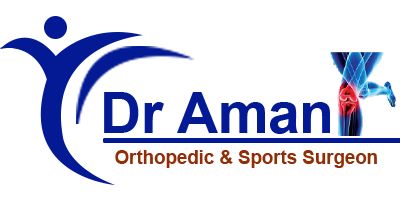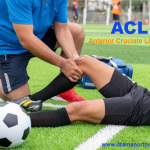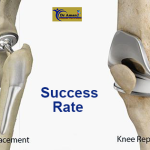ACL Tears: A Thorough Guide
Table of Contents
Introduction
In the world of sports and physical activity, ACL tears pose a common challenge for athletes and fitness enthusiasts. This guide provides in-depth insights into ACL tears, unraveling the causes, symptoms, and various treatment options. Whether you’re an athlete recovering from an injury or an individual curious about these ligament tears, this guide aims to be a valuable resource in the realm of ACL injuries.
What is an ACL Tear?

The anterior cruciate ligament (ACL) is a crucial component of the knee, connecting the femur to the tibia. It acts as a resilient strap that prevents excessive bending or twisting of the knee joint. When subjected to forces beyond its limit, the ACL can suffer tears, categorized into three grades based on severity.
Types of ACL Injuries
- Grade 1: Mild damage without complete tearing.
- Grade 2: Partial tearing with noticeable laxity.
- Grade 3: Complete tear, leading to instability.
How ACL Tears Occur
Understanding the mechanics behind ACL tears is crucial. Typically, these injuries transpire during abrupt movements like pivoting or cutting, prevalent in sports like football, basketball, and soccer. However, ACL tears can also result from workplace incidents or automobile accidents.
Recognizing ACL Tear Symptoms
Identifying an ACL tear involves paying attention to specific symptoms:
- A distinct “pop” or “snap” during the injury.
- Immediate swelling of the knee.
- Difficulty bearing weight on the affected leg.
- Instability in the knee joint.
Diagnosing ACL Tears
Physicians employ a combination of history, physical examination, and imaging tests like X-rays or MRI scans to diagnose ACL tears accurately. These assessments also help evaluate potential collateral ligament or cartilage injuries associated with ACL tears.
Grades of ACL Tears: What They Mean
Understanding the severity of ACL tears is crucial for devising an appropriate treatment plan.
- Grade 1: Mild stretching without compromising stability.
- Grade 2: Partial tear leading to some instability.
- Grade 3: Complete tear, resulting in significant instability.
Treatment Options
The approach to ACL tears depends on factors like the patient’s symptoms, age, and the extent of ligament damage.
Nonsurgical Treatment
Grade 1 injuries often respond well to nonsurgical treatments such as immobilization, bracing, and physical therapy. A gradual return to regular activities is emphasized.
Surgical Treatment
Grade 3 or complete ACL tears often necessitate surgical intervention, commonly through ACL reconstruction. Surgical decisions consider factors like the patient’s growth plates, specific injury type, and future sports or activity goals.
Special Considerations for Pediatric ACL Injuries
Children and adolescents with open growth plates require careful consideration in ACL treatment to avoid disrupting growth. Treatment plans are tailored to ensure future growth remains unimpeded.
ACL Surgery: A Detailed Overview
ACL reconstruction surgery involves replacing the torn ligament with a graft, either from the patient’s tissues or a donor. This outpatient procedure employs minimally invasive arthroscopic techniques, ensuring a quicker recovery compared to traditional open surgery.
Recovery Timeline
The recovery from ACL surgery spans six to nine months, with a gradual progression from initial immobilization to returning to competitive sports.
Can Teenagers Undergo ACL Surgery?
Innovations in surgical techniques, such as All-Inside, All-Epiphyseal Reconstruction, now allow ACL reconstruction in youth athletes without compromising growth plates. This breakthrough provides a ray of hope for young athletes looking to resume their active lifestyles.
Prevention Strategies for ACL Tears
While some ACL tears are inevitable, especially in the realm of sports, adopting preventive measures can significantly reduce the risk. This includes proper warm-up, using protective gear, and engaging in knee and lower body strengthening programs.
Living with an ACL Tear
Living with an ACL tear involves understanding the limitations and taking steps to prevent further injuries. Rehabilitation, both pre and post-surgery, plays a pivotal role in restoring strength and flexibility.
Frequently Asked Questions (FAQs)
Q1: Can ACL tears heal on their own?
A: No, a torn ACL cannot heal on its own. While some low-grade tears might be manageable without surgery, a complete tear usually requires surgical intervention for a full recovery.
Q2: How soon after an ACL injury should surgery be considered?
A: Generally, ACL reconstruction surgery is scheduled between three and six weeks after the injury, allowing inflammation to subside. However, the timing depends on various factors, including associated injuries and the patient’s overall condition.
Q3: What are the risks of delaying ACL reconstruction surgery?
A: Delaying ACL reconstruction for six months or longer after the injury may increase the chances of future complications and the need for revision surgeries.
Q4: Can an ACL tear lead to long-term consequences like osteoarthritis?
A: Yes, individuals who have experienced an ACL tear are more prone to developing osteoarthritis in the knee earlier than those without such injuries. Exploring advanced surgical techniques is an ongoing effort to improve long-term outcomes.
Q5: Is ACL surgery a viable option for teenagers with open growth plates?
A: Yes, advancements in surgical techniques, such as All-Inside, All-Epiphyseal Reconstruction, make ACL surgery feasible for teenagers without compromising their growth plates.
Q6: How effective is nonsurgical treatment for ACL tears?
A: Nonsurgical treatment is most effective for low-grade (Grade 1) ACL injuries, involving methods like immobilization, bracing, and physical therapy. However, the appropriate treatment plan depends on the individual’s specific condition.
Q7: What is the role of rehabilitation in ACL surgery recovery?
A: Rehabilitation is integral to ACL surgery recovery, focusing on restoring strength, stability, and range of motion. Supervised rehabilitation by a skilled physical therapist ensures a successful outcome.
Q8: Can individuals resume competitive sports after ACL surgery?
A: Yes, with proper rehabilitation and clearance from healthcare providers, individuals can often return to competitive sports approximately six to nine months post-ACL surgery.
Q9: Are there specific preventive measures to reduce the risk of ACL tears?
A: Yes, adopting measures like proper warm-up, using protective gear, and engaging in knee and lower body strengthening programs can significantly reduce the risk of ACL tears, especially in sports with frequent sudden stops or changes in direction.
Navigating the landscape of ACL tears requires an in-depth understanding of their causes, symptoms, and treatment modalities. Whether you’re on the road to recovery or aiming to prevent these injuries, this guide aims to be a beacon of knowledge, providing insights to empower individuals in their journey towards knee health and resilience. Remember, knowledge is the first step towards a stronger, injury-resistant future.If you are facing the problem of ACL Tears and want to diagnos with qualified orthopedic and sports surgeon.For Appointment please follow our facebook page




